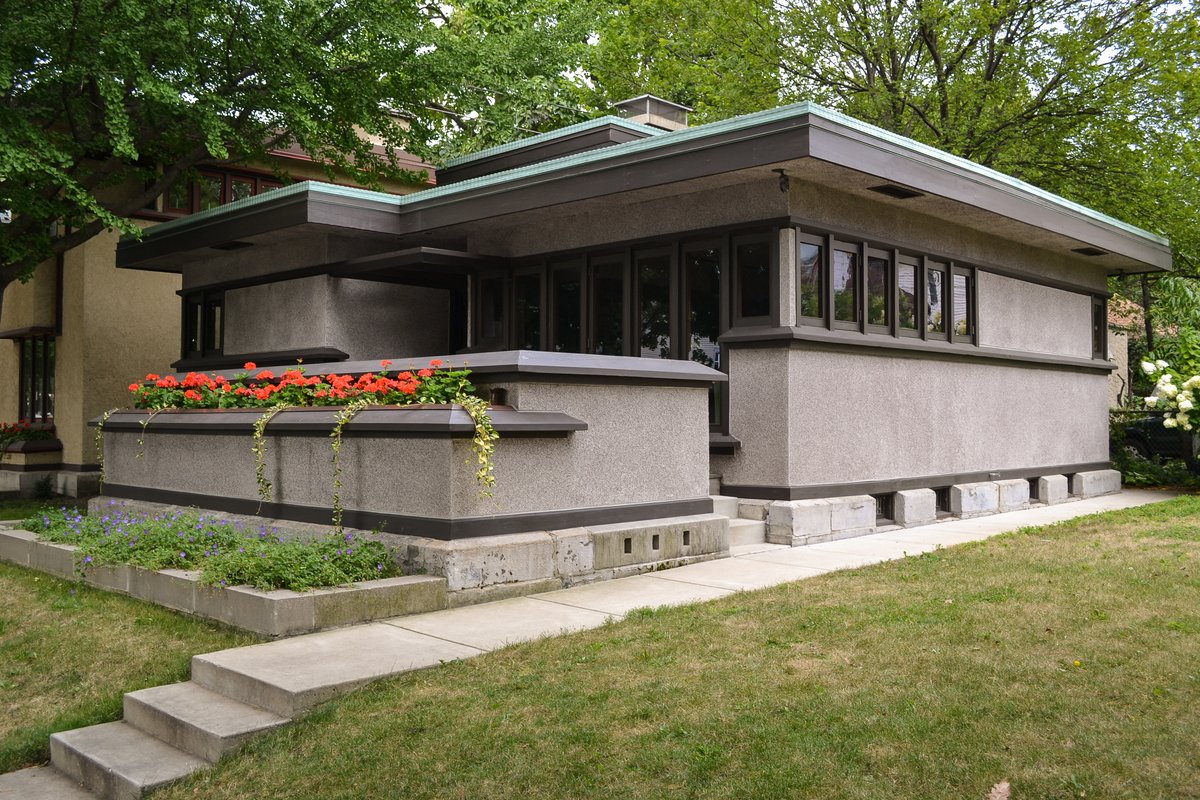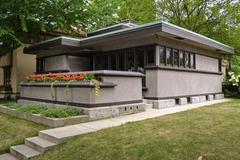
American System-Built Homes Milwaukee: Comprehensive Visiting Guide, History, and Practical Tips
Date: 15/06/2025
Introduction
The Burnham Block on Milwaukee’s historic Old Polish South Side stands as a living testament to Frank Lloyd Wright’s American System-Built Homes (ASBH) project—an early 20th-century initiative to provide affordable, architect-designed housing to working-class Americans. Unlike the era’s custom-built homes, Wright’s vision leveraged factory-cut materials and standardized designs to democratize quality architecture, making it both beautiful and economical. Today, the Burnham Block is the largest and most intact collection of ASBH homes, offering visitors a unique opportunity to explore Wright’s revolutionary work up close. This guide covers the Burnham Block’s history, design, significance, visiting hours, ticketing, tours, accessibility, nearby attractions, and essential visitor tips. Whether you’re an architecture enthusiast, history buff, or traveler, this resource will help you make the most of your visit.
For further historical context and additional details, see Wright in Milwaukee and the Frank Lloyd Wright Trail.
Table of Contents
- Origins of the American System-Built Homes
- The Burnham Block’s Historical and Social Context
- Design Philosophy and Construction Techniques
- Project Evolution, Decline, and Preservation
- Visiting the Burnham Block: Hours, Tickets, and Tours
- Accessibility and Practical Tips
- Nearby Attractions and Events
- Visual and Interactive Resources
- Frequently Asked Questions (FAQ)
- Conclusion and Call to Action
- References
Origins of the American System-Built Homes
At the dawn of the 20th century, Frank Lloyd Wright sought to solve a pressing social challenge: quality, affordable housing for America’s working class. Inspired by his belief in the power of industrialization to reduce costs and waste, Wright envisioned a “system” where homes were composed of standardized, factory-cut materials assembled on site. This approach aimed to replace inefficient, labor-intensive custom building with a streamlined, cost-effective process—without sacrificing architectural integrity (wrightinmilwaukee.org; franklloydwright.org).
Wright’s collaboration with Milwaukee manufacturer Arthur L. Richards (1911–1917) produced over 900 working drawings and sketches, more than for any other project in his archive. The homes’ modularity and adaptability allowed for a variety of models suited to different site conditions and family needs (archive.curbed.com).
The Burnham Block’s Historical and Social Context
Constructed between 1915 and 1917, the Burnham Block became the principal testing ground for the ASBH concept. Located on Milwaukee’s then-periphery in a predominantly working-class, Polish neighborhood, the Burnham Block was uniquely conceived as a cohesive architectural ensemble rather than a scattered collection of individual commissions. Its placement in a thriving homeownership community aligned with Wright’s vision of dignified, affordable housing for the masses (wrightinmilwaukee.org; architectureadrenaline.com).
Design Philosophy and Construction Techniques
Wright’s ASBH project marked a shift from his earlier Prairie School designs for wealthy clients to a focus on inclusivity. As he asserted, “I would rather solve the small house problem than build anything else I can think of” (franklloydwright.org). The system-built approach employed pre-cut materials shipped from a central factory, reducing on-site labor costs and material waste.
Key Features
- Standardization with Variety: Over thirty standardized models, each with subtle variations, provided flexibility for different sites (Wright in Milwaukee).
- Prairie School Influence: Low-pitched roofs, broad eaves, horizontal lines, and bands of windows fostered a connection with nature and emphasized interior openness.
- Efficient Layouts: Compact floor plans, strategic window placement, and built-in furnishings maximized light and space, making the modest homes feel open and livable.
- Affordable Materials: Use of cost-effective yet attractive materials, such as stained gumwood, ensured beauty on a budget.
- Human Scale: Every design decision prioritized comfort, community, and the dignity of the occupants.
Project Evolution, Decline, and Preservation
By 1917, Wright and Richards had enlisted over a dozen licensed dealers to market ASBH homes, with prices ranging from $2,750 to $3,500 for smaller units and up to $100,000 for larger models—remarkably affordable for architect-designed houses (franklloydwright.org). However, America’s entry into World War I led to material shortages, economic instability, and a sharp decline in homebuilding. The project’s momentum faltered, and Wright soon moved on to other commissions. Fewer than 20 ASBH homes were ultimately built, with the Burnham Block standing as the most significant surviving cluster (archive.curbed.com).
Over the decades, the Burnham Block suffered from neglect and alterations. Today, thanks to restoration by local advocates and organizations like Wright in Wisconsin, several homes—including the Model B1—have been returned to their original splendor and are open for public tours (wrightinmilwaukee.org).
Visiting the Burnham Block: Hours, Tickets, and Tours
Location
2714–2732 West Burnham Street, Milwaukee, WI 53215
Part of the Frank Lloyd Wright Trail.
Visiting Hours
- Standard Tours: Friday and Saturday afternoons (May–September) with additional Saturday tours year-round.
- Tour Times: Typically on the hour from 11:00 AM to 2:00 PM; check the official website for the current schedule and seasonal variations.
- Arrival: Arrive 10–15 minutes before your tour for check-in.
Tickets and Reservations
- Admission: Usually $15 per adult; children under 16 are free with a parent (Peek).
- Purchase: Advance online booking is required via the Wright in Milwaukee website.
- Cancellation: Refunds are available for cancellations made at least 24 hours in advance.
- Group/Private Tours: Contact [email protected] for group rates or special arrangements.
Guided Tours
- Content: Docent-led tours include interior access to two restored homes—Model B1 and Two-Family Flat “C”—with commentary on Wright’s design, construction, and restoration.
- Tour Duration: Approximately 40–50 minutes, including outdoor and indoor segments.
- Special Events: Periodic special tours, lectures, or seasonal events are announced on the official website and social media.
Photography and Conduct
- Photography: Exterior photography is generally allowed. Interior photography may be restricted; ask your docent for current policies.
- Visitor Guidelines: Please avoid touching surfaces, leaning on walls, or bringing food/drink inside the homes.
Accessibility and Practical Tips
- Wheelchair Access: Due to the historic nature of the buildings, accessibility is limited. Entrances may have steps, and interiors are narrow. Contact the site in advance for specific accommodations.
- Restrooms: No public restrooms are available; plan accordingly.
- Parking: On-street parking is available, but may be limited during peak times.
- Public Transit: The site is accessible via Milwaukee’s bus routes.
- Dress: Wear comfortable shoes and weather-appropriate clothing, as tours include outdoor walking.
- Arrive Early: Early arrival ensures a smooth check-in and maximizes your tour experience.
Nearby Attractions and Events
- Mitchell Park Domes: Unique horticultural conservatory nearby.
- Historic Third Ward: Vibrant district with dining, shopping, and culture.
- Milwaukee Public Museum & Art Museum: For a broader historical and cultural experience.
- Holler House & Koz’s Mini Bowl: Quaint, historic taverns and bowling alleys nearby (Atlas Obscura).
- Special Events: Annual Wright & Like tours, lectures, and community open houses—see the Wright in Milwaukee website for announcements.
Visual and Interactive Resources
- Virtual Tours and Galleries: Access high-quality images, virtual tours, and interactive maps on the Wright in Milwaukee website and Frank Lloyd Wright Trail site.
- Alt Tags: Images include SEO-friendly alt text such as “Burnham Block Milwaukee historic homes” and “Frank Lloyd Wright American System-Built Homes exterior.”
- Apps: Download the Frank Lloyd Wright Trail app for navigation and multimedia content.
Frequently Asked Questions (FAQ)
Q: What are the visiting hours?
A: Guided tours run from 11:00 AM to 2:00 PM on select days; check the official schedule.
Q: How do I buy tickets?
A: Tickets must be purchased in advance online via the Wright in Milwaukee website.
Q: Is the site wheelchair accessible?
A: Accessibility is limited due to historic layouts; contact the site for specifics.
Q: Are restrooms available?
A: No public restrooms on site.
Q: Can I take photos?
A: Exterior photography is generally allowed; check with your docent for interior policies.
Q: Are pets or food/drinks allowed?
A: Pets are not permitted. No food or drink inside the homes.
Q: Can children attend tours?
A: Yes, but homes are not childproofed; supervise children closely.
Conclusion and Call to Action
The Burnham Block remains a rare, invaluable example of Frank Lloyd Wright’s commitment to social progress, architectural innovation, and the democratization of beautiful, functional homes. Its preservation offers visitors a unique lens into early 20th-century American ideals and the ongoing relevance of thoughtful design.
Plan your visit today:
- Book tickets and check hours at the Wright in Milwaukee website.
- Download the Frank Lloyd Wright Trail app for an enhanced experience.
- Consider supporting preservation efforts by joining Friends of the Burnham Block or making a donation.
- Stay informed about special events by following Wright in Milwaukee on social media.
Experience the power of design to shape community and history—discover the Burnham Block, where innovation and accessibility converge.
References and Further Reading
- Exploring the Burnham Block: Visiting Hours, Tickets, and History of Milwaukee’s American System-Built Homes, 2024, Wright in Milwaukee (http://wrightinmilwaukee.org/learn_an_american_home.html)
- Visiting the Burnham Block: Frank Lloyd Wright’s Affordable Housing in Milwaukee – Hours, Tickets, and Historical Insights, 2024, Wright in Wisconsin (https://wrightinwisconsin.org/american-system-built-homes)
- Burnham Block Milwaukee: Visiting Hours, Tickets, Tours, and Historical Insights, 2024, Frank Lloyd Wright Trail (https://franklloydwrighttrail.org/sites/frank-lloyd-wrights-burnham-block)
- Frank Lloyd Wright Burnham Block Visiting Hours, Tickets, and Visitor Guide to Milwaukee’s Historic American System-Built Homes, 2024, Wright in Milwaukee (http://wrightinmilwaukee.com/)
- Additional archival and news resources, including (https://archive.curbed.com/2016/12/16/13984492/frank-lloyd-wright-prefab-american-system-built)
- Atlas Obscura
- Abus on a Dusty Road
- Peek
- Milwaukee Magazine
- Wanderlog
- architectureadrenaline.com
- tourdeforce360.com

























